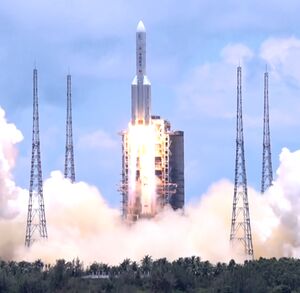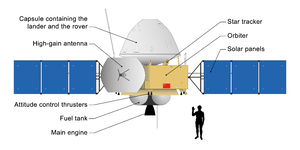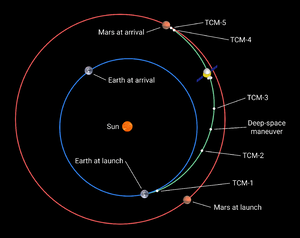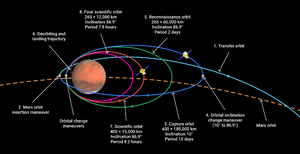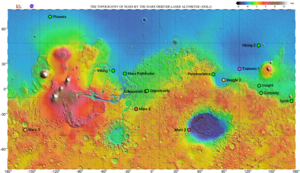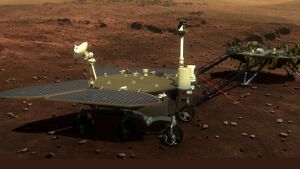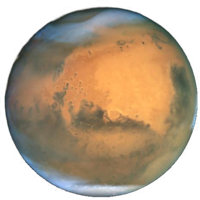تيانون-1
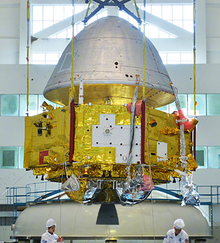 The Tianwen-1 orbiter (below) and the capsule housing the lander and Zhurong rover (top). | |
| طبيعة المهمة | Mars exploration |
|---|---|
| المشغل | CNSA |
| COSPAR ID | 2020-049A |
| SATCAT № | 45935 |
| مدة المهمة |
|
| خصائص المركبة الفضائية | |
| مركبة الافضاء |
|
| المصنع | CNSA |
| وزن الإطلاق |
|
| الأبعاد | Zhurong: 2.6 m × 3 m × 1.85 m |
| بداية المهمة | |
| تاريخ الإطلاق | 23 July 2020, 04:41:15 UTC[2] |
| الصاروخ | Long March 5 (Y4) |
| موقع الإطلاق | Wenchang LC-101 |
| المقاول | China Aerospace Science and Technology Corporation |
| Mars orbiter | |
| مكوّن مركبة فضاء | Orbiter |
| Orbital insertion | 10 February 2021, 11:52 UTC[3][4] |
| Mars lander | |
| مكوّن مركبة فضاء | Lander |
| Landing date | 14 May 2021, 23:18 UTC[5][6][7] |
| Landing site | Utopia Planitia[8] 25°06′N 109°54′E / 25.1°N 109.9°ECoordinates: 25°06′N 109°54′E / 25.1°N 109.9°E[9] |
| Mars rover | |
| مكوّن مركبة فضاء | Zhurong |
| Landing date | 14 May 2021[10] |
| Landing site | Utopia Planitia[8] |

| |
Tianwen-1 (TW-1; الصينية المبسطة: 天问؛ الصينية التقليدية: 天問؛ حرفياً: Heavenly Questions�) is an interplanetary mission by the China National Space Administration (CNSA) to send a robotic spacecraft to Mars, consisting of an orbiter, deployable camera, lander and the Zhurong rover.[11] The spacecraft, with a total mass of nearly five tons, is one of the heaviest probes launched to Mars and carries 13 scientific instruments.
The scientific objectives of the mission relate to the geology of Mars, the current and past presence of water, the internal structure of the planet, identification of minerals and rock types on the surface, as well as characterization of the space environment and atmosphere of Mars.
The mission was launched from the Wenchang Spacecraft Launch Site on 23 July 2020[12] on a Long March 5 heavy-lift launch vehicle. After seven months of transit, it entered orbit around Mars on 10 February 2021.[13][4] For the next three months the space probe studied the target landing sites from a reconnaissance orbit. On 14 May 2021, the lander successfully landed on Mars.[11] With the landing, China became the third nation to achieve a successful soft landing on Mars, after the Soviet Union and the United States.[14] If the deployment of the rover is also successful, China would become only the second nation to accomplish this feat, after the United States,[1][15] and the first nation to orbit, land and release a rover during its first mission to arrive at Mars.[16]
The Tianwen-1 mission was the second of three Martian exploration missions launched during the July 2020 window, with missions also launched by the national space agencies of the United Arab Emirates (Emirates Mars Mission with the Hope orbiter) and the United States (Mars 2020 with the Perseverance rover and Ingenuity helicopter drone).
. . . . . . . . . . . . . . . . . . . . . . . . . . . . . . . . . . . . . . . . . . . . . . . . . . . . . . . . . . . . . . . . . . . . . . . . . . . . . . . . . . . . . . . . . . . . . . . . . . . . . . . . . . . . . . . . . . . . . . . . . . . . . . . . . . . . . . . . . . . . . . . . . . . . . . . . . . . . . . . . . . . . . . . .
التسمية
تيانون
- TW; الصينية المبسطة: 天问؛ الصينية التقليدية: 天問؛ حرفياً: Heavenly Questions�
On 24 April 2020, China's planetary exploration mission was officially named "Tianwen Series", the first Mars exploration mission was named "Tianwen-1", and subsequent planetary missions were numbered sequentially.[17]
The name Tianwen means "questions to heaven" or "quest for heavenly truth", and comes from the long poem of the same name written by Qu Yuan (ح. 340–278 BC), a poet of ancient China.[18][19]
المركبة الجوالة ژورونگ
المركبة الاستكشافية ژورونگ على سطح المريخ، 19 مايو 2021.
On 24 April 2021, in anticipation of the upcoming landing attempt, CNSA formally announced that the rover is to be named Zhurong, after a Chinese mytho-historical figure usually associated with fire and light.[20] The name was selected by a public online vote held between 20 January 2021 and 28 February 2021, with Zhurong ranking first with 504,466 votes.[21] Some Chinese commentators suggest that the naming of the Tianwen-1 Mars rover after Zhurong is meant to "ignite the fire of interstellar exploration in China and to symbolize the Chinese people's determination to explore the stars and to uncover unknowns in the universe".[22]
المحاولة المبكرة

China's Mars program started in partnership with Russia. In November 2011, the Russian spacecraft Fobos-Grunt, destined for Mars and Phobos, was launched from Baikonur Cosmodrome. The Russian spacecraft carried with it an attached secondary spacecraft, the Yinghuo-1, which was intended to become China's first Mars orbiter (Fobos-Grunt also carried experiments from The Planetary Society and Bulgaria). However, Fobos-Grunt's main propulsion unit failed to boost the Mars-bound stack from its initial Earth parking orbit and the combined multinational spacecraft and experiments eventually reentered in the atmosphere of Earth in January 2012.[23] China subsequently began an independent Mars project.[24]
نظرة عامة
The new Chinese Mars spacecraft, consisting of an orbiter and a lander with an attached rover, is developed by the China Aerospace Science and Technology Corporation (CASC) and managed by the National Space Science Centre (NSSC) in Beijing.[25] The mission was formally approved by Chinese authorities in 2016, and became a reality five years later.[26] It was launched from Wenchang Spacecraft Launch Site on the Chinese island of Hainan atop a Long March 5 heavy-lift launch vehicle on 23 July 2020.[12]
In September 2020, the Tianwen-1 orbiter deployed the Tianwen-1 Deployable Camera (TDC), a small satellite with two cameras that took photos of and tested a radio connection with Tianwen-1.[27] Its mission was to photograph the Tianwen-1 orbiter and the lander's heat shield. [27]
The orbiter also completed two mid-course orbital corrections and performed self diagnostics on multiple payloads.[28] The spacecraft has begun to conduct scientific operations with the Mars Energetic Particle Analyzer, mounted on the orbiter, which has already transmitted data back to ground control.[29]
After the lander touches down on Mars, the Zhurong will be released. This rover will be powered by solar panels and is expected to probe the Martian surface with radar and to perform chemical analyses on the soil; it would also look for biomolecules and biosignatures.[1]
أهداف المهمة
This is China's first interplanetary mission, as well as its first independent probe to Mars. The goal is therefore first of all to validate the communication and control technologies in deep space, the placing in orbit around the planet and the landing on its surface. The orbiter must also make it possible to locate a site for a future return of Martian samples.
From a scientific point of view, the mission must meet five objectives:
- Study the morphological and geological structure of Mars, as well as its evolution and its causes. To do this, the probe will analyze the topography of the planet with precise data from characteristic regions such as the dry bed of rivers, the reliefs of volcanoes, wind erosion, glaciers at the poles, etc. The two cameras present on the orbiter are dedicated to this objective.
- Study the characteristics of the surface and underground layers of the soil of Mars, as well as the distribution of water ice. This is the role of the radars present on the orbiter and the rover.
- Study the composition and type of rocks as well as the minerals and elements present on the surface of Mars. Analyze the carbonate or weathering minerals present in ancient lakes, rivers, and other landscapes resulting from the past presence of water on the planet, such as hematites, lamellar silicates, sulphate hydrates or even perchlorate minerals in order to establish the link with the watery past of Mars. The spectrometers on board the orbiter and the rover as well as the multispectral camera are dedicated to this objective.
- Study the ionosphere, the climate, the seasons, and more generally the atmosphere of Mars, both in its near-space environment and on its surface. This is the role of the two particle detectors present on the orbiter as well as of the rover's weather station.
- Study the internal structure of Mars, its magnetic field, the history of its geological evolution, the internal distribution of its mass, and its gravitational field. The magnetometers as well as the radars present on the orbiter and the rover are dedicated to this objective.[30]
The aims of the mission include searching for evidence of current and past life, producing surface maps, characterizing soil composition and water ice distribution, and examining the Martian atmosphere, and in particular its ionosphere.[31]
The mission also serves as a technology demonstration that will be needed for an anticipated Chinese Mars sample-return mission proposed for the 2030s.[32] Zhurong will also cache rock and soil samples for retrieval by the later sample-return mission.[33]
تخطيط المهمة
In late 2019, the Xi'an Aerospace Propulsion Institute, a subsidiary of China Aerospace Science and Technology Corporation (CASC), stated that the performance and control of the future spacecraft's propulsion system has been verified and had passed all requisite pre-flight tests, including tests for hovering, hazard avoidance, deceleration and landing. The main component of the lander's propulsion system consists of a single engine that provides 7,500 N (1,700 lbf) of thrust. The spacecraft's supersonic parachute system had also been successfully tested.[26]
CNSA initially focused on the Chryse Planitia and Elysium Mons regions of Mars in its search for possible landing sites. However, in September 2019 during a joint meeting in Geneva, in Switzerland, of the European Planetary Science Congress-Division for Planetary Sciences, Chinese presenters announced that two preliminary sites in the Utopia Planitia region of Mars have instead been chosen for the anticipated landing attempt, with each site having a landing ellipse of approximately 100 by 40 kilometres.[26]
In July 2020, CNSA provided landing coordinates of 110.318° East longitude and 24.748° North latitude, within the southern portion of Utopia Planitia, as the specific primary landing site. The area appears to provide a relatively safe place for a landing attempt but is also of great scientific interest, according to Alfred McEwen, director of the Planetary Image Research Laboratory at the University of Arizona.[8] Simulated landings have been performed as part of mission preparations by the Beijing Institute of Space Mechanics and Electricity.[34]
By 23 January 2020, the Long March 5 Y4 rocket's hydrogen-oxygen engine had completed a 100-seconds test, which was the last engine test prior to the final assembly of the launch vehicle. It successfully launched on 23 July 2020.[12]
. . . . . . . . . . . . . . . . . . . . . . . . . . . . . . . . . . . . . . . . . . . . . . . . . . . . . . . . . . . . . . . . . . . . . . . . . . . . . . . . . . . . . . . . . . . . . . . . . . . . . . . . . . . . . . . . . . . . . . . . . . . . . . . . . . . . . . . . . . . . . . . . . . . . . . . . . . . . . . . . . . . . . . . .
دخول مدار المريخ
The three Tianwen-1 spacecraft were launched by Long March 5 Heavy-lift launch vehicle on 23 July 2020. Having traveled for about seven months, it entered Mars orbit on 10 February 2021 by performing a burn of its engines to slow it down just enough to be captured by Mars' gravitational pull. The orbiter spent several months scanning the surface to refine the target landing zone for the lander/rover.[35][36][19] It approached at about 265 km (165 mi) to Mars' surface, allowing a high-resolution camera to return images to the Earth and to map the landing site in Utopia Planitia.[37][معلومات قديمة]
الإبرار على المريخ
At 23:18 UTC, on 14 May 2021, the Tianwen-1 lander successfully landed in the preselected landing area in the southern part of the Mars Utopia Planitia.[5][38][39][40][41] The landing phase began with the release of the protective capsule containing the lander/rover. The capsule made an atmospheric entry followed by a descent phase under parachute, after which the lander used retro-propulsion to soft-land on Mars.[6][7][39]
Current plans call for the lander to deploy the rover Zhurong on 22 May 2021.[42] The rover is designed to explore the surface for 90 sols; its height is about 1.85 m (6.1 ft) and it has a mass of about 240 kg (530 lb). After the planned rover deployment, the orbiter would serve as a telecommunications relay for the rover while continuing to conduct its own orbital observations of Mars.[22]
Chinese President Xi Jinping stated in response to the landing, "You were brave enough for the challenge, pursued excellence and placed our country in the advanced ranks of planetary exploration. Your outstanding achievement will forever be etched in the memories of the motherland and the people."[43]
الأجهزة العلمية
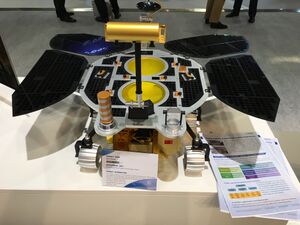
To achieve the scientific objectives of the mission, the Tianwen-1 orbiter and Zhurong are equipped with 13 instruments:[44]
المركبة المدارية
- Medium-Resolution Camera (MRC) with a resolution of 100 m from a 400 km orbit
- High-Resolution Camera (HRC) with a resolution of 2 m from a 400 km orbit
- Mars Magnetometer (MM)
- Mars Mineralogy Spectrometer (MMS), to determine elementary composition
- Orbiter Subsurface Radar (OSR)
- Mars Ion and Neutral Particle Analyzer (MINPA)
- Mars Energetic Particle Analyzer [44]
المركبة الجوالة ژورونگ
- Ground-Penetrating Radar (GPR), to image about 100 m (330 ft) below the Martian surface [15]
- Mars Surface Magnetic Field Detector (MSMFD)
- Mars Meteorological Measurement Instrument (MMMI)
- Mars Surface Compound Detector (MSCD), combines laser-induced breakdown spectroscopy and infrared spectroscopy [45]
- Multi-Spectrum Camera (MSC)
- Navigation and Topography Camera (NTC)
التعاون الدولي
Argentina's Comisión Nacional de Actividades Espaciales (CONAE) is collaborating on Tianwen-1 by way of a Chinese-run tracking station installed in Las Lajas, Neuquén. The facility played a previous role in China's landing of the Chang'e-4 spacecraft on the far side of the Moon in January 2019.[46]
France's Institute for Research in Astrophysics and Planetology (IRAP) in Toulouse, in France, is collaborating on the Zhurong rover. Sylvestre Maurice of IRAP said, "For their Laser Induced Breakdown Spectroscopy (LIBS) instrument, we have delivered a calibration target that is a French duplicate of a target which is on NASA's Curiosity Mars rover. The idea is to see how the two datasets compare".[46]
Austria's Austrian Research Promotion Agency (FFG) aided in the development of a magnetometer installed on the Tianwen-1 orbiter. The Space Research Institute of the Austrian Academy of Sciences in Graz has confirmed the group's contribution to the Tianwen-1 magnetometer and helped with the calibration of the flight instrument.[46]
قالب:Features and artificial objects on Mars
. . . . . . . . . . . . . . . . . . . . . . . . . . . . . . . . . . . . . . . . . . . . . . . . . . . . . . . . . . . . . . . . . . . . . . . . . . . . . . . . . . . . . . . . . . . . . . . . . . . . . . . . . . . . . . . . . . . . . . . . . . . . . . . . . . . . . . . . . . . . . . . . . . . . . . . . . . . . . . . . . . . . . . . .
ردود الفعل الدولية
NASA Associate Administrator Thomas Zurbuchen tweeted his congratulations, saying, “Together with the global science community, I look forward to the important contributions this mission will make to humanity’s understanding of the Red Planet.”[47]
Director General of Roscosmos Dmitry Rogozin praised China’s successful mission stating, "The landing of China's spacecraft on the surface of Mars is a great success of China's fundamental space research program."[48]
انظر أيضاص
- Astrobiology
- Climate of Mars
- Chinese Deep Space Network
- Exploration of Mars
- European Space Agency
- ESTRACK
- Mars Express orbiter
- List of missions to Mars
- Life on Mars
- Emirates Mars Mission, UAE 2020 Mars mission with its Hope orbiter
- Mars sample-return mission
المصادر
- ^ أ ب ت "China Exclusive: China's aim to explore Mars". Xinhua. 21 March 2016. Retrieved 24 March 2016.
- ^ Wall, Mike (23 July 2020). "China launches ambitious Tianwen-1 Mars rover mission". Space.com. Retrieved 12 February 2021.
- ^ "天问一号探测器飞行里程突破3亿千米" [Tianwen-1 Has Flown More Than 300 Million Kilometers] (in Chinese). 17 November 2020. Retrieved 12 January 2021.
{{cite web}}: CS1 maint: unrecognized language (link) - ^ أ ب Gebhardt, Chris (10 February 2021). "China, with Tianwen-1, begins tenure at Mars with successful orbital arrival". NASASpaceFlight.com. Retrieved 10 February 2021.
- ^ أ ب "我国首次火星探测任务着陆火星取得圆满成功". CNSA. Archived from the original on 2021-05-15. Retrieved 2021-05-15.
科研团队根据"祝融号"火星车发回遥测信号确认,5月15日7时18
- ^ أ ب "天问一号成功着陆火星!". 2021-05-15.
- ^ أ ب "官宣!7时18分!"天问一号"探测器成功着陆火星". 2021-05-15.
- ^ أ ب ت Jones, Andrew (28 October 2020). "China chooses landing site for its Tianwen-1 Mars rover". Space.com. Retrieved 16 November 2020.
- ^ "China's 1st Mars rover 'Zhurong' lands on the Red Planet". Retrieved 2021-05-15.
- ^ "China is about to land its Zhurong rover on Mars".
The same Chinese space watchers who revealed the impending descent also report that Zhurong will begin exploration on 22 May
- ^ أ ب Myers, Steven Lee; Chang, Kenneth (14 May 2021). "China's Mars Rover Mission Lands on the Red Planet - The success establishes China as a principal contender in what some see as a new era of space competition". The New York Times. Retrieved 15 May 2021.
- ^ أ ب ت Jones, Andrew (23 July 2020). "Tianwen-1 launches for Mars, marking dawn of Chinese interplanetary exploration". SpaceNews. Retrieved 23 July 2020.
- ^ Roulette, Joey (5 February 2021). "Three countries are due to reach Mars in the next two weeks". The Verge. Retrieved 7 February 2021.
- ^ "China succeeds on country's first Mars landing attempt with Tianwen-1". nasaspaceglight.com. 15 May 2021. Retrieved May 15, 2021.
- ^ أ ب The subsurface penetrating radar on the rover of China's Mars 2020 mission, B. Zhou, S. X. Shen, Y. C. Ji, 2016 16th International Conference on Ground Penetrating Radar (GPR), 13–16 June 2016
- ^ "China's Tianwen-1 spacecraft completes historic Mars landing". aljazeera.com. Retrieved May 15, 2021.
- ^ "中国首次火星探测任务命名为"天问一号"" [China's first Mars exploration mission named "Tianwen No. 1"]. Beijing Daily APP News (in الصينية). Retrieved 2021-04-30.
{{cite web}}: CS1 maint: url-status (link) - ^ "China's First Mars Exploration Mission Named Tianwen-1". Xinhua. 24 April 2020. Retrieved 24 April 2020.
- ^ أ ب Yeung, Jessie (10 February 2021). "Tianwen-1, China's mission to Mars, has entered orbit". CNN. Retrieved 12 February 2021.
- ^ Hua, Xia (24 April 2021). "China's first Mars rover named Zhurong". Xinhuanet.com. Retrieved 24 April 2021.
- ^ ""祝融号"荣登榜首!中国首辆火星车全球征名投票结束". 2021-03-02. Archived from the original on 2021-04-24.
- ^ أ ب 高孟阳 Gao Mengyang. "定了!"祝融号"——中国首辆火星车有名字了!" [Deal! "Zhurong"—China's first Mars rover has a name!]. CCTV News (in الصينية). Retrieved 2021-04-30.
{{cite web}}: CS1 maint: url-status (link) - ^ Zolotukhin, Alexei (15 January 2012). "Russian Phobos-Grunt Mars probe falls in Pacific Ocean". RIA Novosti. Retrieved 16 January 2012.
Phobos-Grunt fragments have crashed down in the Pacific Ocean
{{cite news}}: CS1 maint: url-status (link) - ^ Nan, Wu (24 June 2014). "Next stop – Mars: China aims to send rover to Red Planet within six years". South China Morning Post. Retrieved 23 February 2016.
- ^ "Tianwen-1 (China's first Mars Exploration Mission)". eoPortal Directory.
- ^ أ ب ت Jones, Andrew (8 November 2019). "China Says Its Mars Landing Technology Is Ready For 2020". IEEE Spectrum. Retrieved 30 December 2019.
- ^ أ ب Clark, Stephen. "China's Mars-bound probe returns self-portrait from deep space". Spaceflight Now. Retrieved 14 December 2020.
- ^ "China's Mars probe completes deep-space maneuver". Xinhua. 10 October 2020. Retrieved 10 October 2020.
- ^ Lei, Zhao (29 July 2020). "Mars probe begins science operations". China Daily. Retrieved 12 February 2021.
- ^ Jia Yingzhuo, Fan Yu, Zou Yongliao (2018). "Scientific Objectives and Payloads of Chinese First Mars Exploration" (PDF). Retrieved 13 July 2020.
{{cite web}}: CS1 maint: multiple names: authors list (link) - ^ Zhou; et al. (13–16 June 2016). "The subsurface penetrating radar on the rover of China's Mars 2020 mission". 2016 16th International Conference on Ground Penetrating Radar (GPR). pp. 1–4. doi:10.1109/ICGPR.2016.7572700. ISBN 978-1-5090-5181-6. S2CID 306903.
- ^ Normile, Dennis (25 June 2020). "Mars mission would put China among space leaders". Science. Retrieved 12 February 2021.
- ^ Lozovschi, Alexandra (17 January 2019). "China Plans To Land A Rover On Mars In 2020". Inquisitr.
- ^ Lei, Zhao (3 December 2019). "Country making strides toward Mars mission". China Daily. Retrieved 12 February 2021.
- ^ Jones, Andrew (5 January 2021). "China's Tianwen-1 spacecraft will reach Mars orbit on 10 February 2021". SPACE.com. Retrieved 12 February 2021.
- ^ Amos, Jonathan (10 February 2021). "China Mars mission: Tianwen-1 spacecraft enters into orbit". BBC News. Retrieved 10 February 2021.
- ^ Jones, Andrew (10 February 2021). "China's Tianwen-1 enters orbit around Mars". SpaceNews. Retrieved 12 February 2021.
- ^ "China's Tianwen-1 set to attempt Mars rover landing on Friday". cnet.com. Retrieved May 12, 2021.
- ^ أ ب "China lands its Zhurong rover on Mars". bbc.com. Retrieved May 14, 2021.
- ^ "科普贴 "祝融"成功登陆火星 为何选择在"乌托邦"? 恐怖9分钟经历了什么?". 2021-05-15.
- ^ "天問一號探測器登陸「烏托邦平原」 中國火星着陸任務創歷史". 2021-05-15.
- ^ "China is about to land its Zhurong rover on Mars".
The same Chinese space watchers who revealed the impending descent also report that Zhurong will begin exploration on 22 May
- ^ "China completes historic Mars spacecraft landing". Reuters. 2021-05-15. Retrieved 2021-05-15.
- ^ أ ب "China launches robotic mission to orbit, land, and drive on Mars". Spaceflight Now. 23 July 2020. Retrieved 24 July 2020.
- ^ Zou, Yongliao; Zhu, Yan; Bai, Yunfei; Wang, Lianguo; Jia, Yingzhuo; Shen, Weihua; Fan, Yu; Liu, Yang; Wang, Chi; Zhang, Aibing; Yu, Guobin; Dong, Jihong; Shu, Rong; He, Zhiping; Zhang, Tielong; Du, Aimin; Fan, Mingyi; Yang, Jianfeng; Zhou, Bin; Wang, Yi; Peng, Yongqing (2021). "Scientific objectives and payloads of Tianwen-1, China's first Mars exploration mission". Advances in Space Research. 67 (2): 812–823. doi:10.1016/j.asr.2020.11.005. ISSN 0273-1177.
- ^ أ ب ت David, Leonard (22 July 2020). "China's Tianwen-1 Mars rover mission gets a boost from international partners". SPACE.com. Retrieved 10 September 2020.
- ^ "China lands on Mars in latest advance for its space program". apnews.com. Retrieved May 15, 2021.
- ^ "Russian space corporation praises China's first Mars landing". xinhuanet.com. Retrieved May 15, 2021.
- Articles containing صينية-language text
- CS1 maint: url-status
- CS1 الصينية-language sources (zh)
- Coordinates not on Wikidata
- مقالات تحتوي نصوصاً باللغة الصينية
- Spaceflight infobox standardisation - phase 2
- مقالات تحتوي نصوصاً باللغة الصينية المبسطة
- مقالات تحتوي نصوصاً باللغة الصينية التقليدية
- Wikipedia articles in need of updating from مايو 2021
- Chinese space probes
- Mars rovers
- Missions to Mars
- Astrobiology space missions
- Six-wheeled robots
- Space probes launched in 2020
- 2020 in China
- July 2020 events in Asia
- 2021 on Mars
- مقالات تحتوي مقاطع ڤيديو

